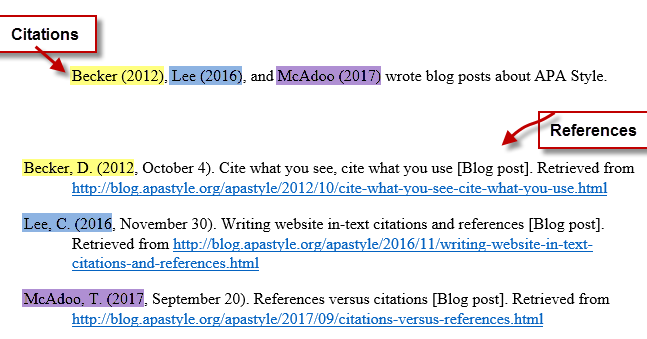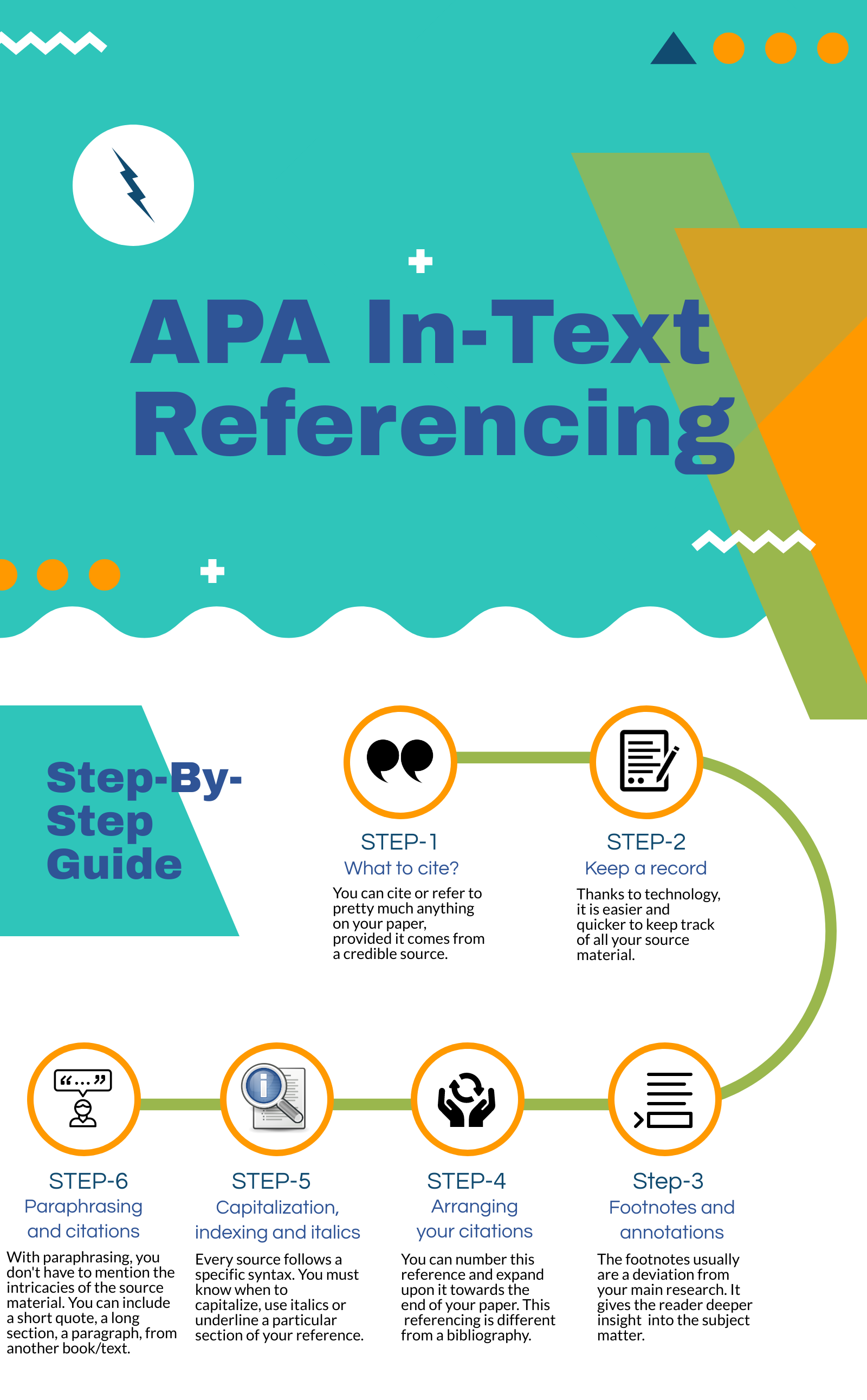Step-by-step guide for APA in-text referencing

Citations and referencing are perhaps one of the most complicated aspects of any research paper. Students swamped with assignments know what I am talking about here. Writing an essay from scratch is not an overnight job. It involves meticulous planning and proofreading.
In-text referencing adds more substance to your paper. It gives the reader an accurate list of all the sources, books and journals referred to in the research.
Most universities accept the APA in-text referencing for academic dissertations. Here is all you need to know about APA style referencing and how to apply it to your research. Check out the step-by-step guide below for more details.

Steps to APA citations
APA referencing style, developed by the American Psychological Association, is the preferred format for stat-based papers. Students have to follow a set of guidelines to refer a para from a book or article. In case you don’t have all the publication details, merely stating the author’s name and date is enough.
In-text referencing is when you try to add references in between the research paper. Note that you should even cite the sources if you paraphrase from it.
Step 1: What to cite?
Now, you can cite or refer to pretty much anything on your paper, provided it comes from a credible source. Earlier, students only referred to articles, journals and scientific books and studies. These sources were mostly hard-copies and available at libraries.
With the advent of technology, your scope for procuring information widened considerably. Today you can find information in documentaries, websites, online journals, and other digital platforms.
So, how do you cite these sources? Well, that is what I am here to tell you. Let us learn about the different sources and how to list them in your paper.
The interface is user-friendly, reliable, and reasonably accurate.
Whole books
Divided the references into two parts- primary sources and secondary sources. The primary sources are the core texts and books you base your paper on. You can base your entire research on a particular study or scholarly article.
Now, you don’t have to cite the same text every time you refer to it in the paper. With APA in-text referencing, you can find the source in brief. List the surname of the author, followed by the publication year. The basic format of referencing whole books would be.
- List the author’s name or initials
- Add the title, i.e. name of the book
- The edition details
- The editor, translator, compiler or revisor
- The publication company,
- Year of publication
- Date of publication

Parts/sections of books
Sometimes, you might have to refer to certain paragraphs from different authors and papers. This is what I refer to as secondary sources. The source material here is not as crucial as the para or the section you are referring to.
Keep a record of all these sections as and when you read them. I also suggest students note the page numbers of these said sections. This makes things a lot easier for you when you’re curating the bibliography at the end of your paper. Include these details in the cite in this order.
- Author name and surname (use the initials if you’re referring to it frequently)
- Title of the text or article
- The page number/chapter
Journals and papers
Journals and research papers are different from regular books. Records come in editions, over several volumes. Also, you can read through research papers as independent studies. It deals with a specific topic, idea, or hypothesis in detail.
When you refer to books, you add the publication details and the author. With journals, you also have to add the magazine, volume number and edition of the source material. Digital or electronic records require the website URL as well.
Here is the structure you can follow when citing journals as per APA 6th style referencing.
- Author’s surname or initials
- Title of the article
- Name of the journal or magazine
- Issue number and volume
- The edition number,
- Year of publication
- Editor, translator, and publisher
- Page number
Citations are necessary even when paraphrase or copy the idea from another source.
Electronic sources
Students these days get a significant chunk of their information from the internet. There are numerous platforms where you can find rare papers, book editions and journals. With websites, you also need to record the time and date of access.
Mention the URL, the edition, the title of the article, author name, among other details. Here is how you cite an electronic article in APA style
- Author name or initials
- Title of the document
- Publication details
- Title of the webpage or website
- URL of the website
- The page number of sections of the passage
- Year of the publication (or the last update)
- Date and time of access
- Database name
- Email address
Step 2: Keep a record
With in-text citations, you reduce the risk of missing out on some of the references used in the paper. And thanks to technology, it is easier and quicker to keep track of all your source material. There are platforms where you can find readymade citations.
These citation generators can structure your references in MLA, APA, or Harvard styles. All you need to do is specify the text, book, paper, journal, or website URL. It’ll also help if you organize your references digitally.
There are platforms which also arranges your bibliography for you in ascending order. APA style is usually organized in ascending order with the author’s surname preceding their name. In case you don’t have the author’s name, you can arrange that citation by its title.

Step 3: Footnotes and annotations
You can also add footnotes, annotations along with the in-text citations. With annotations, you can provide more context to your references. It gives you the space to add some extra information about the text or your topic.
The footnotes usually are a deviation from your main research. It gives the reader deeper insight into the subject matter. You can add a footnote towards the end of the page and number it accordingly so that its easier to identify.
Microsoft Word makes your job simpler. Here, you can create citations, add annotated bibliographies and footnotes with just a click.

Step 4: Arranging your citations
Consult your peers and professors about the arrangement and placement of the citations. Some teachers prefer that you add in-text references that appear in the middle of the paper. The quotation, here, appears in brackets, with the surname of the author and the year of publication.
You can number this reference and expand upon it towards the end of your paper. Note that this referencing is different from a bibliography. In bibliographies, you simply state the name of the book/text. In citations, you mention other publication details as well.
I would recommend online apps like EndNote to students who want instant and readymade citations. The interface is user-friendly, reliable, and reasonably accurate.
Step 5: Capitalization, indexing and italics
We have already discussed the structuring of the citations. You know the essential elements of a referencing list. However, every source also follows a specific syntax. You must know when to capitalize, use italics or underline a particular section of your reference.
- Always capitalize the first letter of proper nouns, like the author’s name, initials, and title of the text.
- When mentioning the name of a book ensure that all the letters are capitalized except for the prepositions.
- Keep the name of the text is italicized and if not in italics, under quotations markings.
- Usually, books, journals, and magazines are italicized, and papers are put in quote marks.

Step 6: Paraphrasing and citations
Remember, citations are necessary even when paraphrase or copy the idea from another source. With paraphrasing, you don’t have to mention the intricacies of the source material. You can include a short quote, a long section, a paragraph, from another book/text.
Note that when you copy from another source, it’s better to insert it as a separate para. Leave some space and add the quote at a closer margin. You can also justify (centre placement) the text to separate it from the rest of your paper.
What is APA referencing?
There are three main referencing styles, followed by most academic institutions. Professors recommend either of these formats, depending on the content and context of your paper.
The MLA style, for instance, is ideal for literary reviews. Harvard and APA referencing are suitable for academic journals. APA, in particular, follows a more specific format that allows students to list the author, date and publication details in an organized way.
APA in-text citations follow the conventional author-date method. Students must list the last name of the author, followed by the publication year of the source. You can add the page number, source text title and other details as well.

Quick links and references
APA citation guides: Online Writing Lab by Purdue University
Citation generator: Citethisforme
Harvard citation guidelines: Harvard Citation Format by Mendeley
APA in-text citation samples: In-text APA citations by National University
The Bottom Line
APA referencing can get quite complicated if you don’t know the rules. I hope that this guide would help you understand the basic pointers of APA citations. It adds more credibility of the paper and protects you from plagiarism accusations.


